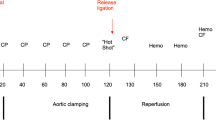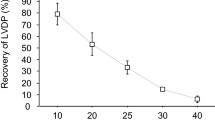Abstract
The effects of changing the calcium content of a continuous warm hyperkalemic crystalloid cardioplegia (CWCP) were investigated in an isolated rat heart preparation. The hearts were divided into eight groups of six each. A control group consisted of fresh nonarrested hearts and the remaining seven groups consisted of hearts perfused with continuous hyperkalemic (20 mM) modified Krebs-Henseleit bicarbonate buffer solution with calcium concentrations of 0.1, 0.3, 0.5, 1.0, 1.5, 2.0, or 2.5 mM, for either 180 or 240 min at 37°C. In the hearts arrested for 180 min, there were no significant differences in postarrest cardiac functions between the control group and any of the groups perfused with calcium concentrations of 0.5 mM or more. With a calcium concentration of 0.1 mM, the calcium paradox was provoked. The change in the calcium content of CWCP perfused for 240 min significantly affected myocardial protection. Maximum aortic flow recovery, of 74.5%±2.7%, and minimum CK release, of 15.7±2.4IU/15 min/g dry weight, were observed in hearts perfused with a calcium concentration of 1.5 mM. The calcium paradox occurred even at a calcium concentration of 0.3 mM; therefore, normal calcium concentrations should be maintained in cardiac surgery to prevent cardiac injury.
Similar content being viewed by others
References
Salerno TA, Houck JP, Barrozo CAM (1991) Retrograde continuous warm blood cardioplegia: a new concept in myocardial protection. Ann Thorac Surg 51:245–247
Engelman RM, Auvil J, O'Donoghue MJ, Levitsky S (1978) The significance of multidose cardioplegia and hypothermia in myocardial preservation during ischemic arrest. J Thorac Cardiovasc Surg 75:555–563
Hearse DJ, Braimbridge MV, Jynge P (1981) Protection of the ishemic myocardium: cardioplegia. Raven, New York, pp 167–208
Shine KI, Douglas AM (1983) Low calcium reperfusion of ischemic myocardium. J Mol Cell Cardiol 15:251–260
Poole-Wilson PA, Harding DP, Bourdillon PDV, Tones MA (1984) Calcium out of control. J Mol Cell Cardiol 16:175–187
Ferrari R, Albertini A, Curello S (1986) Myocardial recovery during post-ischaemic reperfusion: effects of nifedipine, calcium and magnesium. J Mol Cell Cardiol 18:487–498
Kuroda H, Ishiguro S, Mori T (1986) Optimal calcium concentration in the initial reperfusate for post-ischemic myocardial perfomance (calcium concentration during reperfusion). J Mol Cell Cardiol 18:625–633
Neely LR, Liebermeister H, Battersby EJ, Morgan HE (1967) Effect of pressure development on oxygen consumption by isolated rat heart. Am J Physiol 212:804–814
Yamamoto F, Braimbridge MV, Hearse DJ (1984) Calcium and cardioplegia: the optimal calcium content for the St. Thomas' Hospital cardioplegic solution. J Thorac Cardiovasc Surg 87:908–912
Robinson LA, Harwood DL (1991) Lowering the calcium concentration in St. Thomas' Hospital cardioplegic solution improves protection during hypothermic ischemia. J Thorac Cardiovasc Surg 101:314–325
Zimmerman ANE, Daems W, Hulsmann W, Snijder J, Wisse E, Durrer D (1967) Morphological changes of heart muscle caused by successive perfusion with calcium-free and calcium-containing solutions (calcium paradox). Cardiovasc Res 1:201–209
Frank JS, Rich TL, Beydler S, Kreman M (1982) Calcium depletion in rabbit myocardium: ultrastructure of the sarculemma and correlation with the calcium paradox. Circ Res 51:117–130
Frank JS, Langer GA, Nudd LM, Seraydarian K (1977) The myocardial cell surface, its histochemistry, and the effect of sialic acid and calcium removal on its structure and cellular ionic exchange. Circ Res 41:702–714
Jynge, P (1983) Calcium-free cardioplegia contra. Eur Heart J 4 (suppl H):161–168
Hess P, Tsien RW (1984) Mechanism of ion permeation through calcium channels. Nature 309:453–456
Hohl CM, Alschuld RA, Brierly GP (1983) Effects of calcium on the permeability of isolated adult rat heart cells to sodium. Arch Biophys 221:197–205
Hearse DJ, Humphrey SM, Bullock GR (1978) The oxygen paradox and the calcium paradox: two facets of the same problem? J Mol Cell Cardiol 10:641–668
Murphy JG, Marsh JD, Smith TW (1987) The role of caliium in ischemic myocardial injury. Circulation 75 (suppl V):V15-V24
Chambers DJ, Dunham J, Braimbridge MV, Slavin B, Quiney J, Chayen J (1983) The effect of ionized calcium, pH, and temperature on bioactive parathyroid hormone during and after openheart operations. Ann Thorac Surg 36:306–313
Rebeyka IM, Robert A, Axford-Gatley RA, Bush BG (1990) Calcium paradox in an in vivo model of multidose cardioplegia and moderate hypothermia: prevention with diltiazem or trace calcium levels. J Thorac Cardiovasc Surg 99:475–483
Author information
Authors and Affiliations
Rights and permissions
About this article
Cite this article
Nakamura, Y., Takemoto, N., Kuroda, H. et al. The advantages of normocalcemic continuous warm cardioplegia over low calcemic cardioplegia in myocardial protection. Surg Today 29, 884–889 (1999). https://doi.org/10.1007/BF02482780
Received:
Accepted:
Issue Date:
DOI: https://doi.org/10.1007/BF02482780




